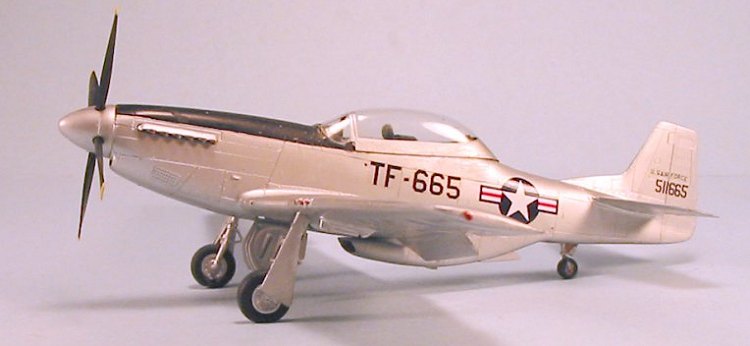
| KIT: | ICM 1/48 TF-51D Mustang (Conversion) |
| KIT #: | ? |
| PRICE: | $10.95 |
| DECALS: | Three options |
| REVIEWER: | Tom Cleaver |
| NOTES: | Falcon TF-51D canopy used. |

| HISTORY |
By the end of the Korean War, the career of the F-51D Mustang had run its course with the United States Air Force. Many Mustangs had been lost operationally during the war, the result of using an aircraft that was technically ill-suited for operation in the role of ground attack. The only explanation that has ever been put forth as to why the USAF used the liquid-cooled F-51 - which could be brought down with a single shot in the radiator - rather than the radial-engined F-47D and F-47N Thunderbolts that were easily available and had been proven in the role during the Second World War is that a Mustang only cost $65,000.00 while the F-47 cost over $100,000.00. One wonders what was the price tag for all the pilots sacrificed in this economic decision, given that the Mustang units had the highest KIA loss rates of any Air Force units in the war?
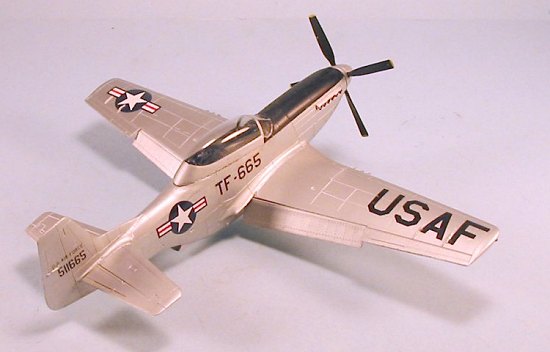 At any rate, in
late 1953, the F-51Ds which had been taken from National Guard units during
the war were returned to their former operators. There weren’t as many
available, so the standard Air Guard unit decreased in size from 25
Mustangs to 16. An IRAN line was established at Norton AFB in San
Bernardino, California, to recondition the active-duty F-51D aircraft for
reassignment to the Air National Guard. These Mustangs were given an
overall coat of aluminum lacquer, with a flat black anti-glare panel that
completely covered the upper panels of the engine cowling. One last
modification came as a corrective action measure following a landing
accident. The tail wheel indication system had been deleted on all
Mustangs following the P-51B-5, which made it possible for a pilot to
unknowingly land with the tail wheel up. To remedy this, the tail wheels
of all F-51Ds were fixed in the down position, with the tail wheel well
doors removed and a canvas boot attached to keep slush and dirt out of the
fuselage. Finally, the fuselage fuel tanks were removed.
At any rate, in
late 1953, the F-51Ds which had been taken from National Guard units during
the war were returned to their former operators. There weren’t as many
available, so the standard Air Guard unit decreased in size from 25
Mustangs to 16. An IRAN line was established at Norton AFB in San
Bernardino, California, to recondition the active-duty F-51D aircraft for
reassignment to the Air National Guard. These Mustangs were given an
overall coat of aluminum lacquer, with a flat black anti-glare panel that
completely covered the upper panels of the engine cowling. One last
modification came as a corrective action measure following a landing
accident. The tail wheel indication system had been deleted on all
Mustangs following the P-51B-5, which made it possible for a pilot to
unknowingly land with the tail wheel up. To remedy this, the tail wheels
of all F-51Ds were fixed in the down position, with the tail wheel well
doors removed and a canvas boot attached to keep slush and dirt out of the
fuselage. Finally, the fuselage fuel tanks were removed.
Since many pilots returning from active service to take up flying with the Guard had no experience of piston-engine tail wheel aircraft, the USAF contracted with the Texas Engineering and Manufacturing Company (Temco) of Dallas, to construct 15 two-seat trainers. These aircraft were rebuilt F-51D-25 block aircraft, in which a complete second cockpit with full instrumentation and controls was installed aft of the original cockpit, in the area previously occupied by the fuselage fuel tank. A longer and higher canopy was constructed to fully enclose the rear cockpit with enough room for the pilot to have full range of motion as he would have in the front seat. The first of these conversions had been flown on July 7, 1951, when it was thought there would be a need to transition a large number of jet pilots into the Mustang for service in the Korean War. The TF-51Ds were assigned on a rotating basis to the various Air National Guard fighter squadrons operating the F-51D until the last F-51Ds left service with the Guard in June 1956.
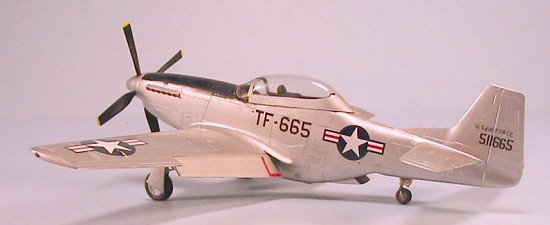 The Mustang
would soldier on for the next 30 years with air forces in Central and South
America, and the TF-51Ds - modernized in the early 1960s by Cavalier
Aircraft as part of the Mustang remanufacturing program to supply F-51Ds to
these air forces - would fly on in their role of operational trainer.
Seven of the original 15 were still operational when the last Mustangs were
turned out of service in the late 1980s and returned to the United States.
The Mustang
would soldier on for the next 30 years with air forces in Central and South
America, and the TF-51Ds - modernized in the early 1960s by Cavalier
Aircraft as part of the Mustang remanufacturing program to supply F-51Ds to
these air forces - would fly on in their role of operational trainer.
Seven of the original 15 were still operational when the last Mustangs were
turned out of service in the late 1980s and returned to the United States.
With the rise of the warbird movement in the United States, access to a Mustang trainer became important for safely transitioning civilian pilots - many with military flying backgrounds but no experience of operating a high-powered piston engine tailwheel airplane - into their privately-owned Mustangs. With insurance requirements favoring those pilots who were graduates of a recognized training program for the Mustang, there was a market for Mustang trainers and Square One Aviation in Chino, California, acquired the necessary license to begin remanufacturing TF-51Ds in the late 1980s. During the course of the past 15 years some 12 of these aircraft have been built to the same standard as the Cavalier updates of the original Temco TF-51Ds, with a strengthened wing spar and a P-51H-style vertical fin and rudder for increased directional control. Most of these airplanes can now be seen in spurious World War II markings, and one of them has been a participant in the Reno Air Races. One of these airplanes is owned and operated by retired Air Force Colonel and Apollo-8 astronaut Frank Borman from his base in New Mexico.
With plans announced in the past few years for the start of commercial production of P-51B and P-51D aircraft with modern production Merlin engines to feed the demand for warbirds, these 2-seater Mustangs could easily be around to celebrate the 80th anniversary of the first flight of the Mustang in 2020, and perhaps beyond even that advanced date.
| THE KIT |
The best 1/48 P-51D kit is that made by Tamiya. Several years ago, the
Ukrainian company ICM produced what can only be called a clone of this kit
- the main parts of which fit interchangeably - with enough changes (all of
which are eminently 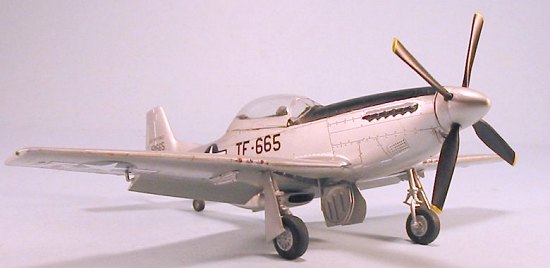 dispensable,
since they are “clones” of parts for the Accurate Miniatures Allison
Mustangs) to avoid copyright infringement of the original. This kit has
the value of being less than half the price of the original; with a bit of
modeling skill involved, the end result will be virtually indistinguishable
from the original kit.
dispensable,
since they are “clones” of parts for the Accurate Miniatures Allison
Mustangs) to avoid copyright infringement of the original. This kit has
the value of being less than half the price of the original; with a bit of
modeling skill involved, the end result will be virtually indistinguishable
from the original kit.
The kit provides some pretty second-rate decals that are best tossed in the round file, particularly since good-quality aftermarket decals are fairly thick on the ground. Adding in a Squadron/Falcon vacuformed canopy and a True Details resin cockpit will still result in a relatively inexpensive project.
While ICM has gone out of business and its successor company, Alanger, has yet to bring production back to pre-bankruptcy levels, the kits can still be found at prices less than the MSRP of about $14.00, making them the kind of bargain a modeler should pick up whenever found, on the theory one can never have too many P-51D kits, given the plethora of markings possibilities one can finish them in.
| CONSTRUCTION |
I had long wanted to do a TF-51D, just to be able to say I had at least one example of every sub-type of my tied-for-first-place favorite fighter (the other being the Supermarine Spitfire). The canopy was always the big drawback; I had thought of making one from wood and vacuforming it, but never got around to it due to the fact I knew there was more to the conversion than just a canopy coupled with a lack of further reference.
 Fortunately, earlier this year Tore Martin of Falcon Clearvax fame decided
to release a “Mustang special” of canopies that included the original
NA-73X prototype, the early “coffin” canopies, a Malcolm hood canopy, both
the Los Angeles and Dallas P-51D canopies and the early “tear drop” bubble
canopy, the P-51H and F-82 canopies, and a TF-51D canopy. The TF-51D
canopy also included a vacuform part for the revised fuselage section
around the rear cockpit. The way was now clear to make a TF-51D.
Fortunately, earlier this year Tore Martin of Falcon Clearvax fame decided
to release a “Mustang special” of canopies that included the original
NA-73X prototype, the early “coffin” canopies, a Malcolm hood canopy, both
the Los Angeles and Dallas P-51D canopies and the early “tear drop” bubble
canopy, the P-51H and F-82 canopies, and a TF-51D canopy. The TF-51D
canopy also included a vacuform part for the revised fuselage section
around the rear cockpit. The way was now clear to make a TF-51D.
There is still not a lot of information on the airplane, and I relied for my conversion on four pictures of the original Temco TF-51D, found in Robert Gruenhagen’s “Mustang: The Story of the P-51 Fighter,” two of which were cockpit photos that gave enough information for a conversion.
 The majority of work involved in the project was the creation of a second
cockpit. Fortunately, I had a Hasegawa P-51 kit that hadn’t seen full
production and had become a “hangar queen” for parts. I used that kit’s
cockpit parts to create the rear cockpit for this TF-51D. It wasn’t that
hard a conversion: I cut off the fuselage tank from the ICM kit’s cockpit
parts, made a floor from .010 Evergreen sheet, and then fitted the Hasegawa
parts into a cockpit with suitable cutting and trimming, after cutting out
the Falcon fuselage part and cutting it in half and installing it on the
fuselage halves of the ICM kit.
The majority of work involved in the project was the creation of a second
cockpit. Fortunately, I had a Hasegawa P-51 kit that hadn’t seen full
production and had become a “hangar queen” for parts. I used that kit’s
cockpit parts to create the rear cockpit for this TF-51D. It wasn’t that
hard a conversion: I cut off the fuselage tank from the ICM kit’s cockpit
parts, made a floor from .010 Evergreen sheet, and then fitted the Hasegawa
parts into a cockpit with suitable cutting and trimming, after cutting out
the Falcon fuselage part and cutting it in half and installing it on the
fuselage halves of the ICM kit.
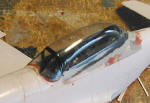 Once the cockpit was created and painted, the rest of the kit construction
was the standard effort to build one of these kits.
Once the cockpit was created and painted, the rest of the kit construction
was the standard effort to build one of these kits.
Probably the hardest part of all was cutting the Falcon canopy to fit to the fuselage, since I only had the one and had to proceed conservatively to avoid a mistake. I had decided to do the model with the canopy closed since the three TF-51Ds out at Chino look better with their canopies closed than when they have they are slid open. Before finally fitting the canopy in position, I polished the model so I could apply an overall aluminum paint job.
| COLORS & MARKINGS |
Painting:
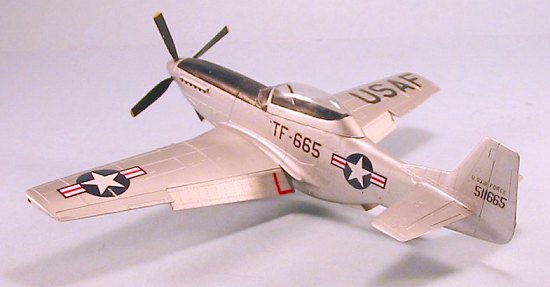 I wish I could have found information on the South American TF-51Ds, and
appropriate national insignia, since the two photos I have seen of these
airplanes in a SEA-style tactical camouflage look very interesting. Since
that wasn’t possible, I decided to do a “white bread” USAF TF-51D as they
appeared when first produced by Temco before being sent to the National
Guard. My thinking here was this was a finish that could later be
“upgraded” if decals became available through the expedience of pulling off
the decals with Scotch tape and giving the model a new paint job.
I wish I could have found information on the South American TF-51Ds, and
appropriate national insignia, since the two photos I have seen of these
airplanes in a SEA-style tactical camouflage look very interesting. Since
that wasn’t possible, I decided to do a “white bread” USAF TF-51D as they
appeared when first produced by Temco before being sent to the National
Guard. My thinking here was this was a finish that could later be
“upgraded” if decals became available through the expedience of pulling off
the decals with Scotch tape and giving the model a new paint job.
The model was painted with SNJ Aluminum paint, with the anti-glare panel and prop glades done with Tamiya X-18 Semi-gloss black.
Decals:
Decals came out of the Mustang wing of the Decal Dungeon, pieced together to make the fifth Temco TF-51D.
| CONCLUSIONS |
It’s a very distinctive-looking Mustang, and one every Mustang lover would want in their collection. This is an easy conversion - in fact, if you have never done a conversion before, this would be a good one to start with. If you have some old Mustang stuff in the spares box, it requires a minimum of scratchbuilding. I just wish someone would come up with a Spitfire T.9 conversion now!
September 2004
Kit courtesy of my wallet.
Canopy set courtesy of Falcon.
If you would like your product reviewed fairly and quickly by a site that has over 250,000 visitors a month, please contact me or see other details in the Note to Contributors.